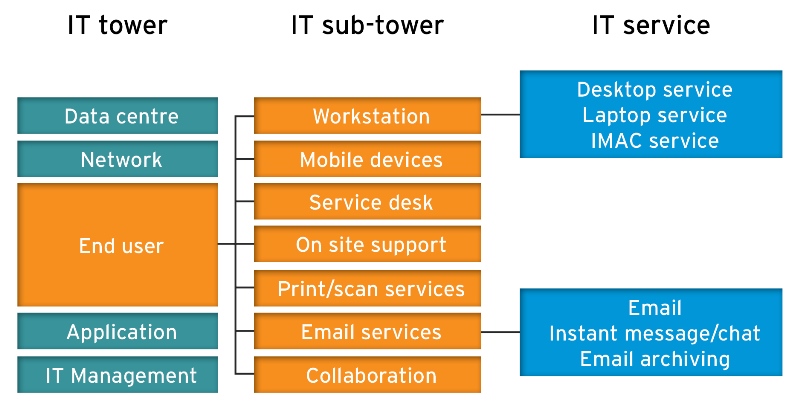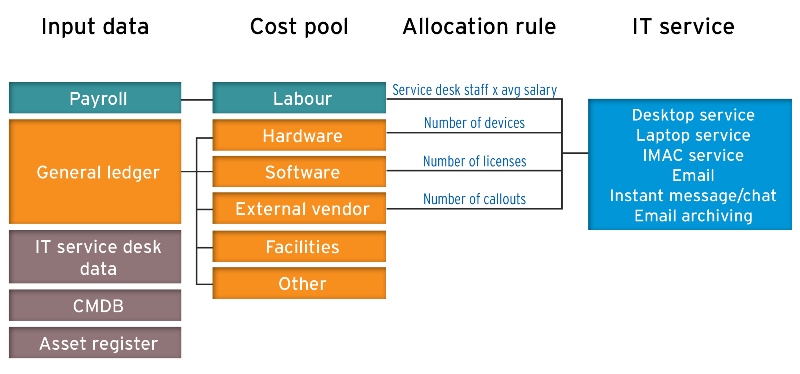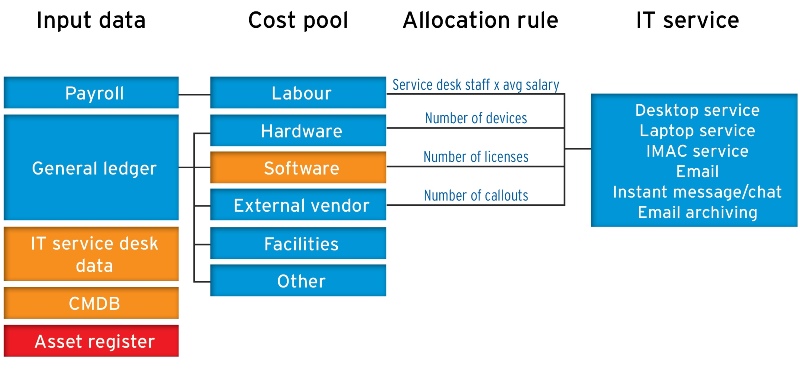The role of the CIO is changing from being a provider of IT services to being a broker of IT services, making the importance of having a solid understanding of the cost of delivering IT services more significant.
CIOs across industries and organisations continue to find themselves under pressure to deliver increasingly complex services in a rapidly changing technological environment.
Coupled with rapid technical changes, IT departments also find themselves responding to increasing demands on their services, often without a requisite increase to their budgets – or worse still, face cuts to their budgets.
The situation is further exacerbated by the absence of a shared language between IT departments and their internal customers, with the consumers of IT services often unaware of how their consumption impacts costs and demands placed on the IT department.
Run the business
- Maximise the value for each IT dollar spent
- Identify areas of inefficiency
Develop the business
- Invest in new technologies
- Embrace agility and be responsive to change
For both the CIO and the CFO, there are a number of fundamental questions regarding “the spend” on IT that many organisations have difficulty in answering.
On the supply side these questions include:
- What are the services that the IT department is/should be delivering for its customers?
- How much is our organisation really spending on IT?
- Where is our IT spend going?
- Whom are we spending our IT dollars with?
- Are we getting the best value for the money we spend?
- Is there a smarter or more efficient way of provisioning the IT resources we need to service our customers?
On the demand side there is a similar set of questions that organisations struggle to answer, for example:
- Do our customers understand how their consumption of these services impact the organisations overall IT spend?
- Are consumers asking for and accessing IT services in an effective manner?
- Is the IT department effectively managing demand?
With the commoditisation of IT and the ongoing rise of commercial off-the-shelf solutions, and the evolution of Cloud, the role of the CIO is changing from being a provider of IT services to that of a broker of IT services. This makes the requirement for a solid understanding of the cost of delivering IT services more significant. Without this, the CIO and the CFO do not have a robust basis to determine whether or not they are getting an acceptable return on their investment in IT dollars.
Costing model
In determining how to improve IT cost efficiency, RSM recommends a five step approach.
1 Adopt an IT service catalogue that your organisation understands
The communication gap between IT departments and the clients they service is well documented. Critical to improving communication between customer and supplier is to consciously move away from speaking to business users using technical jargon centred around hardware, and instead, move to the concept of service based IT, where IT services are articulated in a way that the end-customer clearly grasps the services they are consuming e.g. mobility, voice, end user computing.

2 Develop a cost model for IT services that clearly demonstrates the link between consumption and demand
To improve the level of IT cost awareness across an organisation, a transparent cost model that clearly links consumption of services to demand on IT resources is critical. The introduction of activity based approach to the costing of IT services allows both financial and non-financial data elements (e.g. server usage, number of devices) to be combined to provide a clear and transparent link between consumption and the resultant cost. Without a robust and reliable costing model it is difficult to have an informed and factual discussion with the consumers of IT services on how their usages drives costs. An Activity Based Costing (ABC) costing model provides a transparent mechanism to broker such a dialogue and can form the basis for showback and chargeback to help change IT consumption behaviours that are overly costly to support e.g. is 24-7 support for a marketing application really necessary, when 9-5 support can be shown to cost 33% less?

3 Run real data through the cost model
With an ABC cost model built (ideally using standard industry resource towers and sub-towers), the model can be populated with real data. Depending on the complexity of the cost model and service catalogue, a simple point-in-time Excel analysis may be sufficient as a starting point.
Alternatively, the organisation may choose to invest in a more robust IT cost analytics tool such as those offered by software vendors like VMWare, Apptio and Clearview, that provide more sophisticated analytical capability and the opportunity to refresh results with new data on an ongoing basis.
4 Review, assess and improve the quality of data
One of the biggest reasons organisations resist the implementation of a bottom-up costing model is that they are all too aware that their input data is either of poor quality, or too difficult to access. Many an IT undertaking has fallen short on delivering on its promises due to challenges in putting a credible set of data on the table.
While deficits in data quality cannot be ignored, the upside of committing to the implementation of an ABC model is that it drives an organisation to identify weaknesses in its data, and commit to changes to improve it. For example, if an organisation cannot provide an accurate answer to the question of how many end user devices it supports, it signals a weakness in internal controls and asset management. This could be easily mitigated in the future through a reliable asset tagging process, and short term, a network trawl could provide a reasonably good estimate of the number of devices connected to it. A simple data quality heat map that clearly illustrates areas of the model with data weaknesses is an incredibly powerful tool to focus attention on the areas where data confidence is low.

5 Analyse results and identify opportunities for efficiency gains
Once there is confidence in which areas of the cost model have reliable input data, the organisation is in a position to start analysing the results and identifying opportunities for improving efficiencies. If the costing model has been based on industry standards such as ATUM, this analysis can be made even more effective by overlaying IT benchmarking data e.g. maintenance cost per End User Device, average salary of an IT programmer etc. Because an ABC model includes both financial and consumption data, an organisation can perform analyses that include non-financial data e.g. What is the average utilisation rate of our servers? How many applications does the organisation use to manage the finance process?
This type of analysis assists the organisation to pinpoint where IT efficiencies may be gained.

